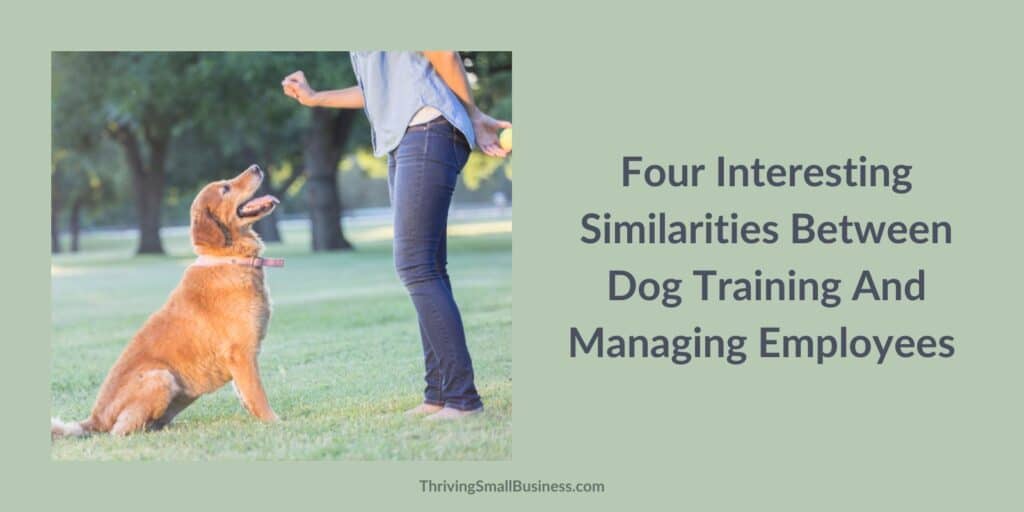Four Similarities Between Dog Training and Employee Management
Estimated reading time: 5 minutes
We have always had dogs. I had lots of dogs as a kid, and when I got married my husband and we have had four dogs.
Like most of you, no one likes to be around a barking, jumping, or misbehaving animal.
We always took the approach of training our own dogs.
However, after the last dog we got, we decided to invest in professional dog training.
My father-in-law jokingly said that the training was for us and not the dog. I think he might be right!
We decided to start our puppy in dog training to help us control some of her less desirable behaviors.
After finishing up her first week of training, we had our “parent-teacher” conference with the dog trainer.
He demonstrated control over the dog in a way that amazed us. He had this puppy sitting, coming on command, and lying down after a few short sessions.
I was surprised at how the simple concepts they taught us for how to “manage” our pooch are so similar to leading and managing employees.
This is what we learned.
What we learned from the dog trainer is that dogs, like humans, need to be told what is expected of them, corrected when they do not follow instructions, and praised and rewarded when they do.
In dog trainer terms, this is the order:
1. Command
2. Correction
3. Praise
4. Reward
A very simple yet effective process that helps the dog learn consistency and expectation for rewards when doing what was expected.
4 Similarities Between Dog Training and Managing Employees
1. Command
This is when you share your expectations with the dog and help them understand the goal.
For instance, we were taught a command to sit. The goal was to encourage the dog to stay seated until a new command was given. The command was the goal.
Similarly, we set employee expectations by providing employees with performance goals.
And while the term “command” would not typically be used in an office setting, the concept is the same.

Help employees understand what is expected of them by clearly communicating what you would like them to do.
For dogs, the command may be to climb onto their dog bed, sit, or come to you.
Commands (expectations) for our employees may be in the form of direction to help them accomplish their goals.
For example, let’s say you have a comment card box in the reception area of your business.
You need to learn what your customers are saying, so you might ask an employee to help by saying something like, “Sue, I would like for you to give me a report on the number of comment cards we’ve received and your recommended plan of action in response to those cards by Friday.”
You are instructing Sue to perform a task which is also an example of SMART goals.
The goal needs to be Specific, Measurable, Attainable, Realistic, and Timely.
2. Correction
Correction comes in when the dog does not follow the command.
In the doggie world, since dogs don’t speak English, one correction method is administered with a pinch collar.
This special collar is placed on the pooch and is pulled to put slight pressure on the dog’s neck to communicate that the behavior they are demonstrating is not the desired behavior.
The pinch collar gains the dog’s attention and is done every time the pup does not follow a command. And, when a command is followed, they get praised.
A pinch collar would probably not work in an office setting, but the concept of correction is the same.
An effective performance management system makes corrections to undesired behaviors so the employee can contribute to accomplishing business goals.
It is important to remember that part of the reinforcement is ensuring employees have the tools and necessary time to perform their job tasks.
As an example, it may not be fair to correct an employee who does not perform good service recovery for a customer when they have not been trained on how to do it.
However, if they have had the training and do not do it, they may need to have a coaching session to help explain the importance of following through with their responsibility to meet the customer’s needs.
3. Praise
Praising is ongoing and should be done every time the dog demonstrates the desired behavior.
As leaders and managers, we should constantly be looking for times to interact with employees and let them know when they are doing a good job.
While correction is vital, praising employees is equally important to help employees understand what success looks like.
This consistent feedback is something that is ongoing.
For instance, let’s say you have an employee who deals with a very demanding customer. You might acknowledge the interaction by saying, “Tina, I observed you dealing with that difficult customer today. Great job diffusing the situation”.
This feedback communicates that you recognized the interaction and that the employee performed as expected and trained.
4. Reward
Like any good performance management system, a good reward is always the carrot to get the desired end result.
In the dog world, they get a dog treat as positive reinforcement for demonstrating desired behaviors.
In our world, the reward would be a nice raise, perhaps a bonus, or sometimes just an extra day off.
Being creative with administering rewards can create a successful reward system.
For example, let’s say you have an employee who went the extra mile to finish a project sooner than expected. You might acknowledge this by saying something like, “Steve, you have met all your goals ahead of schedule, so we are going to give you a $500 gift card to the store of your choice. Thanks for a job well done!”
Small Efforts Lead to Big Results
We have all witnessed the amazing dogs that help with search and rescue, blind people walk or sniff out drugs.
These amazing animals are trained with very simple commands. The highly trained and disciplined animal is a result of consistency in setting expectations, praising, and rewarding.
Managers juggle many responsibilities. One of the most important is managing employees.
In our busy daily lives, while managing our operations. Try to remember these simple concepts and you might be surprised at how they can have a significant impact on accomplishing organizational objectives.






